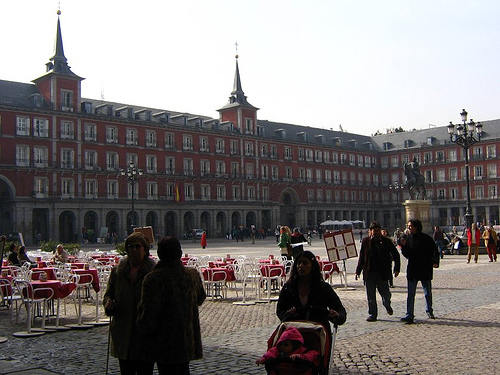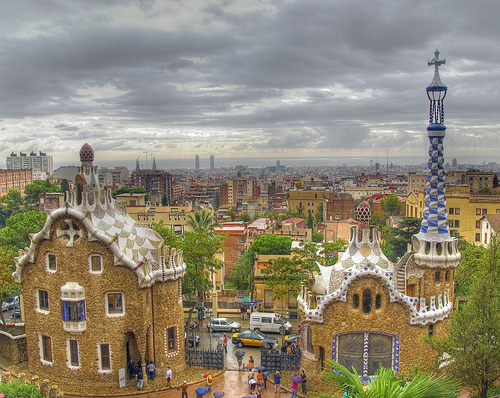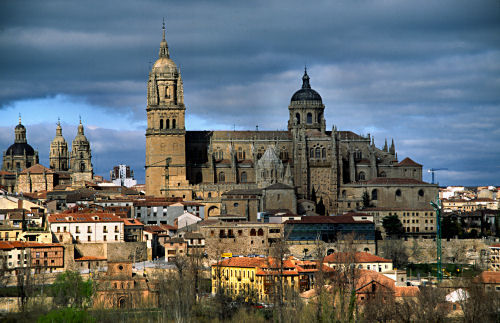Deciding where to begin is the toughest decision
More likely than not, you will not see everything that Spain has to offer. However, there are some key destinations that will give a great first impression of what the country has to offer.
Madrid
Tourist InformationA modern city, the capital of Spain is located at the geographical center of the Iberian Peninsula. Though the city just touches on great architecture, it is most known for its arts and culture. Seventy-three museums, urban gardens and live revelry are definite.
The most noted museum in Madrid is Museo Nacional Del Prado with works by Goya and Velazquez or the more contemporary Reina Sofía National Art Centre and its works by Dalí and Picasso.
Evening dinners in traditional cafes begin nights of bar hopping and dancing hard. Malasaña and areas surrounding the Plaza Dos de Mayor, are foremost areas for an evening out, drinking, or clubbing in Madrid.
If partying isn’t in the agenda, try walking through one many of Madrid’s elaborate parks or spending the afternoon shopping at Princesa, where affordable prices make is popular among the young. El Retiro Park, located behind the Prado. The park surrounds a large lake that accommodates boats. Watch or listen to street performers, notice Madrileños, Madrid citizens, roll, cycle and walk by. Sip on beer or wine at a terraza, an open air bar under the watchful eye of the Angel Caido — a statue said to be the only one dedicated to a fallen angel.
Barcelona
Tourist InformationHost of the 1992 World Olympics, Barcelona is famous for its remarkable historical sites, architecture and monuments, famous exhibits and beaches. The capital of Catalonia, Barcelona sits along the Mediterranean Sea. The Port of Barcelona is one of the most active in the Mediterranean and has services to Ibiza, Italy, and Menorca; private vehicles can be transferred via ferry. The port also functions to serve many cruise liners. People of this city speak Catalan.
An international city, Barcelona maintains a modern appeal in impressive historic beauty. The city displays its own distinctive character through monuments of Romanesque, Gothic and Renaissance eras. Catedral De Barcelona is a 15th century Gothic cathedral that sits on the site of a Paleochristian basilica.
Antoni Gaudi’s work, such as La Sagrada Familia, can be found throughout the city and in the Gaudi Museum. The Picasso Museum, formally the Palau Aguilar, collection is predominately donations from Picasso himself.
Barcelona has 4.5 km of beautiful beaches. La Mar Bella, is located between the Nova Mar Bella and Bogatell, has golden sand. On windy days, the usual still waters give windsurfers great rides. Playa del Bogatell is separated from surrounding beaches by two stone breakwaters. Parking, lifeguard service, showers, restaurants and bars are on locations.
Salamanca
Located in Castile-Leon, real Salamanca puts poscard images to shame. Plateresque and Baroque themes are plentiful in the province’s buildings, monuments and architecture. Rich in culture, Salamanca is home to one of the oldest learning institutions in Spain.
Baroque style El Plaza Mayor, one of Spain’s most beautiful squares, is a three-story high design by Alberto Churriguera. The city hall, located on the north side, has a steeple decorated with fabled figures and five granite arches. A bust of King Philip V decorates the Pabellon Real, or royal pavilion, and large medallions are decorated with the likes of St. Theresa, Charles I and Cervantes. This square is one of the most lively and popular places in Salamanca.
The University of Salamanca is situated only a stone's throw away. Founded in 1254 by Alphonse X, also known as Alphonse the Learned, it is one of the oldest universities in Spain. Galleries surround a central courtyard. Its artistic interest lies in its unique Plateresque façade. The Lesser Schools resemble its larger neighbor in artistic instances. The ceiling of one of the lecture halls was painted by Fernando Gállego.
The Puentes Romano is arched bridge built over the Tormes river, first century A.D. It runs 176 meters long and 3.7 meters wide. Twenty-six semicircle arches and robust pillars have survived centuries. The bridge forms part of the Plata Roman road, that linked Merida with Astorga.


